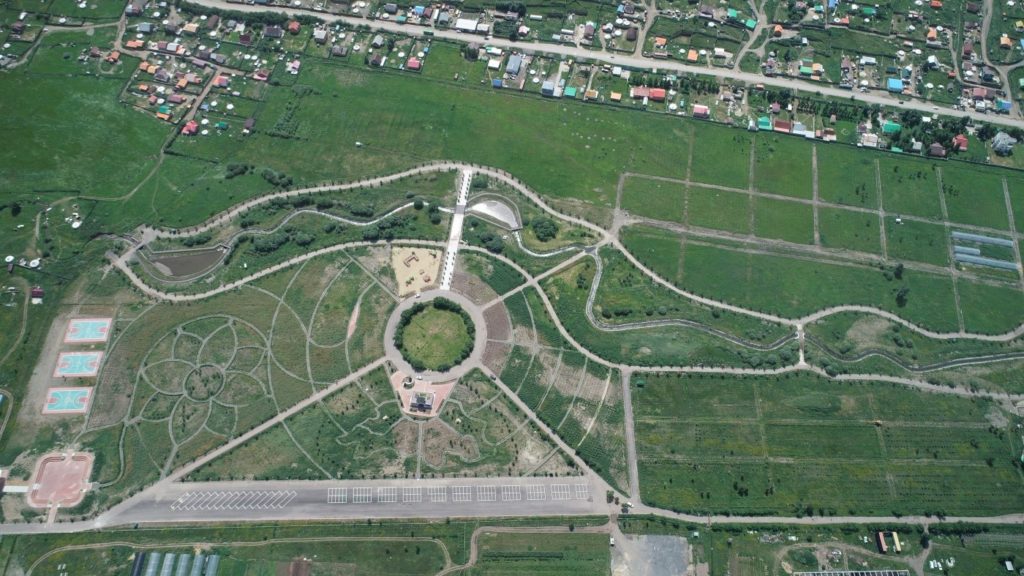Far in the distance, a sight of greenery appears in the middle of the golden Gobi Desert in the southern part of Mongolia. It looks as if the area is a mirage in a mid of a desert. It is the reforested area covered with lush trees planted through one of the successfully implementing forestry projects in Mongolia.
That project is the Korea-Mongolia Greenbelt Reforestation Project initiated by the Ministry of Environment and Tourism of Mongolia (MET) and the Korea Forest Service (KFS) to mitigate desertification and climate change, and combat yellow dust and sandstorms in Mongolia. The project is being implemented in three phases since early 2006 in three soums (district) of two aimags (provinces), which are known as the areas where Asian Dust originates from.
The first phase of the project was initially implemented to support the action plan of Mongolia’s “Green Belt National Program” from 2007-2016 for ten years with the focus on building solid fundamentals for efficient afforestation measures to halt the desertification and land degradation. Main activities included building tree nurseries, conducting capacity-building trainings, and joint researches in Mongolia. The second phase of the bilateral reforestation project was implemented from 2017-2021 for five years and included establishing the urban forest, Mongolian-Korean Friendship Park in the 40-hectare area near the capital city – Ulaanbaatar. Looking ahead now, the third phase of the project will be implemented from 2022-2026 to introduce an advanced forest fire prevention control system from Korea, carry out research and training on agroforestry, and develop healing forests in Mongolia.

Throughout the project implementation period, more than 3,000 hectares of reforested land have been handed over to the Mongolian side step by step. Up until now, the project has successfully planted and grown drought-tolerant tree species including dwarf elm, salt cedar, poplar, pine, birch, willow, and saxaul trees at the target arid sites. The project’s main result is the demonstration of the possibility of planting trees and conducting reforestation even in harsh conditions, where deserted areas are located.
To learn more about how the Greenbelt Project was implemented on the ground and get more insight on the main takeaways of the project results, Mr. Jin Sunpil, Vice Executive Director of AFoCO, has been interviewed as he participated in the second phase of the Greenbelt Project in 2017. Mr. Sunpil Jin worked as the project manager for two years in Mongolia. His main task was to start the urban forest development in Ulaanbaatar and transfer the existing 3,000 hectares of plantation in stages. He stated that his main concern was whether the plantation land could be sustainably managed when it was transferred. This is due to the fact that, after the completion of the first phase of the project, the afforestation land was transferred to Mongolia. However, the management entity and budget were not prepared from the Mongolian side. Since a drip irrigation system was installed in the planted area, continuous management was required, and many poplars created as windbreaks were damaged by pests and diseases. Thus, it must be well noted that deliberate planning and ongoing management are crucial to sustaining the plantations’ growth.
Mr. Jin also indicated that the Greenbelt Project, sponsored by the KFS, valued at $9.5 million and worth $1 million per year until 2016, has positively impacted the livelihoods in the local area. The project included not only afforestation activity to prevent desertification but also education led by domestic trainees, monitoring and joint research projects, dispatch of short-term experts in each field, and publicity through symposiums and workshops. In August 2017, a socio-economic survey was conducted in the area where the reforestation was located. A significant number of survey respondents answered that the Greenbelt Project contributed to job creation and income increase. They recognized that it contributed to environmental sustainability and wind protection and raised residents’ awareness of environmental protection.
The Greenbelt Project of the KFS is evaluated as a successful project that showed excellent results within the “Green Belt National Program” planned by the Mongolian Government. In the meantime, there have been numerous afforestation projects to prevent desertification in Mongolia, but it is difficult to find a systematic and consistent project like this one. He highlighted that the most important task is the sustainable management of afforestation and that the socio-economic surveys, joint research, education and training, and development of agroforestry models promoted through the project were all for sustainability.
Indeed, as approximately 76% of Mongolia’s territory is affected by desertification and land degradation, the Greenbelt Project contributes significantly to resolving these issues. The project also contributes to the national target of increasing the proportion of forestland to 9% by 2030. Although the growth of Mongolian forests is gradual, these slow-growing forests store large amounts of carbon and methane (twice as much carbon per hectare compared with tropical forests). Moreover, the forests prevent erosion on steep mountainsides and act as natural barriers against the encroaching deserts. They also contribute substantially to the livelihoods of rural people in diverse ways. Considering the fact that Mongolian boreal and saxaul forests provide many significant benefits to the country, national counterparts from the Republic of Korea and Mongolia believe that the works being done and lessons learned from the Greenbelt Project will inspire many citizens and lead to more remarkable developments for the forestry sector in the future.
On this subject, Mr. Jin also shared his experiences on project implementation and what must be considered when developing future projects in Mongolia. He stated that the Greenbelt Project was to create a forest by planting trees in deserted grassland where there were no existing trees before. Mr. Sunpil Jin does not recommend the same work to be implemented in the future because such work is not cost-efficient. “However, a large-scale nursery facility is expected to have many efficient uses in Mongolia in the future, so it is one of the projects I would like to propose under the name of ‘Forest Restoration Center,” he spotlighted. Indeed, if the center provides a place for educating residents and is linked to restoration projects and agroforestry, the project will assuredly contribute to sustainability in many ways.
Based on the lessons learned, he believes that Mongolia can strengthen vulnerable areas of national forest management and field expertise through AFoCO. Although AFoCO is not an institution that establishes large-scale funds to conduct projects, he emphasized that AFoCO is open to discussing and developing projects that address critical issues in the forestry sector in Mongolia. Lastly, Mr. Jin hopes that Mongolia will cooperate with AFoCO on the projects needed by linking it with strengthening the capabilities of forestry units.
Contributed by Maralgoo Ganbat, 2021 AFoCO Fellowship Official from Mongolia

